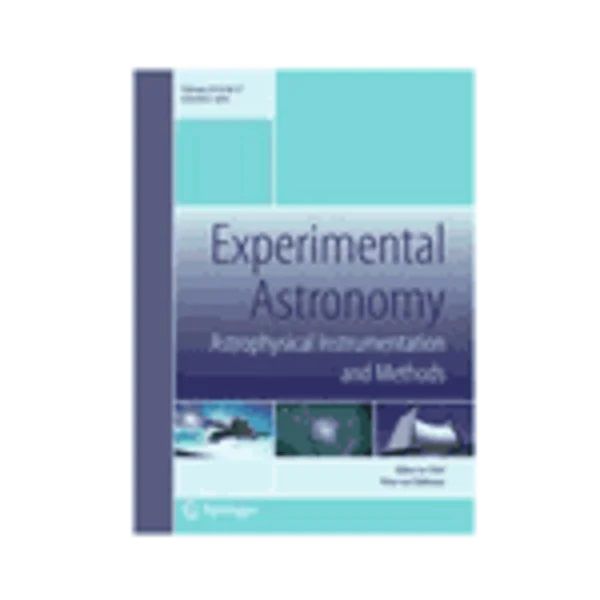-
high precision astrometry mission for the detection and characterization of nearby habitable planetary systems with the nearby earth astrometric telescope (neat)
جزئیات بیشتر مقاله- تاریخ ارائه: 1392/07/24
- تاریخ انتشار در تی پی بین: 1392/07/24
- تعداد بازدید: 1109
- تعداد پرسش و پاسخ ها: 0
- شماره تماس دبیرخانه رویداد: -
a complete census of planetary systems around a volume-limited sample of solar-type stars (fgk dwarfs) in the solar neighborhood (d ≤ 15 pc) with uniform sensitivity down to earth-mass planets within their habitable zones out to several aus would be a major milestone in extrasolar planets astrophysics. this fundamental goal can be achieved with a mission concept such as neat—the nearby earth astrometric telescope. neat is designed to carry out space-borne extremely-high-precision astrometric measurements at the 0.05 μas (1 σ) accuracy level, sufficient to detect dynamical effects due to orbiting planets of mass even lower than earth’s around the nearest stars. such a survey mission would provide the actual planetary masses and the full orbital geometry for all the components of the detected planetary systems down to the earth-mass limit. the neat performance limits can be achieved by carrying out differential astrometry between the targets and a set of suitable reference stars in the field. the neat instrument design consists of an off-axis parabola single-mirror telescope (d = 1 m), a detector with a large field of view located 40 m away from the telescope and made of 8 small movable ccds located around a fixed central ccd, and an interferometric calibration system monitoring dynamical young’s fringes originating from metrology fibers located at the primary mirror. the mission profile is driven by the fact that the two main modules of the payload, the telescope and the focal plane, must be located 40 m away leading to the choice of a formation flying option as the reference mission, and of a deployable boom option as an alternative choice. the proposed mission architecture relies on the use of two satellites, of about 700 kg each, operating at l2 for 5 years, flying in formation and offering a capability of more than 20,000 reconfigurations. the two satellites will be launched in a stacked configuration using a soyuz st launch vehicle. the neat primary science program will encompass an astrometric survey of our 200 closest f-, g- and k-type stellar neighbors, with an average of 50 visits each distributed over the nominal mission duration. the main survey operation will use approximately 70% of the mission lifetime. the remaining 30% of neat observing time might be allocated, for example, to improve the characterization of the architecture of selected planetary systems around nearby targets of specific interest (low-mass stars, young stars, etc.) discovered by gaia, ground-based high-precision radial-velocity surveys, and other programs. with its exquisite, surgical astrometric precision, neat holds the promise to provide the first thorough census for earth-mass planets around stars in the immediate vicinity of our sun.
مقالات جدیدترین رویدادها
-
استفاده از تحلیل اهمیت-عملکرد در ارائه الگوی مدیریت خلاقیت سازمانی و ارائه راهکار جهت بهبود
-
بررسی تاثیر ارزش وجوه نقد مازاد بر ساختار سرمایه شرکت های پذیرفته شده در بورس اوراق بهادار تهران
-
بررسی تأثیر سطح افشای ریسک بر قرارداد بدهی شرکت های پذیرفته شده در بورس اوراق بهادار تهران
-
بررسی تأثیر رتبه بندی اعتباری مبتنی بر مدل امتیاز بازار نوظهور بر نقد شوندگی سهام با تأکید بر خصوصی سازی شرکت ها
-
تأثیر آمیخته بازاریابی پوشاک ایرانی بر تصویر ذهنی مشتری پوشاک ایرانی (هاکوپیان)
-
بررسی آزمایشگاهی اثر افزودنی نانوسیلیس بر رفتار بتن تازه
-
بررسی پاسخ یک قاب دو بعدی با جدا سازی پایه تحت اثر بار باد در شهر کرمانشاه
-
بررسی ویژگی های فردی مؤثر در سکوت سازمانی و تاثیرگذاری آن بر رفتار شهروندی سازمانی
-
بررسی غلظت فلوئور در منابع آب شرب خراسان جنوبی سال 87-1386
-
on the effect of different ratio of perforation’s diameters on crashworthiness of steel cans
مقالات جدیدترین ژورنال ها
-
مدیریت و بررسی افسردگی دانش آموزان دختر مقطع متوسطه دوم در دروان کرونا در شهرستان دزفول
-
مدیریت و بررسی خرد سیاسی در اندیشه ی فردوسی در ادب ایران
-
واکاوی و مدیریت توصیفی قلمدان(جاکلیدی)ضریح در موزه آستان قدس رضوی
-
بررسی تاثیر خلاقیت، دانش و انگیزه کارکنان بر پیشنهادات نوآورانه کارکنان ( مورد مطالعه: هتل های 3 و 4 ستاره استان کرمان)
-
بررسی تاثیر کیفیت سیستم های اطلاعاتی بر تصمیم گیری موفق در شرکتهای تولیدی استان اصفهان (مورد مطالعه: مدیران شرکتهای تولیدی استان اصفهان)
-
تحلیل انتقادی محتوای کتب درسی مدارس از منظر توجه به مفاهیم تربیت شهروندی
-
ارائه یک روش جدید بازسازی متون در تصاویر نویزی مبتنی بر الگوریتم های -p نرم و بردار گرادیان
-
شرح و نقد رای وحدت رویه 652 دیوان عالی کشور مصوب 1380/1/28 با موضوع لغو معافیت دولت از پرداخت هزینه دادرسی
-
بررسی کیفری و جزایی توصیف جرم
-
نقش بهزیستی معنوی و روانی در پیش بینی رفتارهای پرخطر جوانان زندانی شهر زنجان




سوال خود را در مورد این مقاله مطرح نمایید :